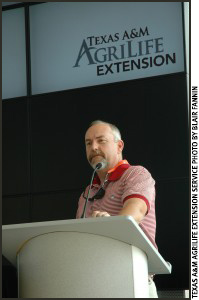Outlook for Grain Market to be Powered by Livestock, Export Demand
Extension economists explore the outlook for farm commodities.

David Anderson, Texas A&M AgriLife Extension Service livestock economist, discusses current trends in the beef cattle market.
Future demand for grain in both the export market and U.S. livestock feeding sector should give farmers profitable opportunities in the years ahead, according to a Texas A&M AgriLife Extension Service economist. A special AgriLife Extension outlook program was hosted by the department of agricultural economics at Texas A&M prior to the Texas A&M-Alabama football game. AgriLife Extension economists provided updates on several agricultural commodities.
Mark Welch, grains marketing economist, said that through the years there has been amazing growth in grain consumption. That momentum doesn’t appear to be changing, he said.
Even though biofuel growth has leveled, Welch said the livestock and export markets are poised for expected growth in the coming years. That’s due to a rebound in U.S. cattle inventories as herd rebuilding will begin once more if drought conditions lift and the expected growth in China develops.
Overall, Welch said, “things are going to stay exciting” with more demand for corn to help further livestock feeding and a continued surge in export market demand.
David Anderson, livestock economist at College Station, said the U.S. beef cattle industry is set for a slow rebuilding process since drought has further delayed herd rebuilding. However, beef consumption and strong export demand signal a continuation of strong beef cattle prices ahead.
Dry weather and lack of forage have prevented many ranchers from retaining replacement heifers and building back herds. The Texas beef cow inventory is 1 million head fewer since the drought started in 2011. Once beef cattle producers can clear the drought hurdle, there are favorable opportunities for the beef cattle market in the future, Anderson said.
“Calf prices are at a profitable level, but you can’t expand due to drought,” he said.
Cotton economist John Robinson, College Station, said China controls a large surplus of cotton, which is affecting prices for both the short and long term. He said it’s likely prices will predictability continue a back-and-forth weakness.
“The futures market has already forecasted that,” he said.
He advised producers to watch China. China may begin to import less U.S. cotton and consume its own supplies more, he said, adding there will be 60¢ cotton if China begins unloading its surplus of supplies.
“We may then be looking ahead at a couple of years of low prices,” Robinson said.
Joe Outlaw, co-director of the Agricultural and Food Policy Center at Texas A&M and Extension economist, provided a farm program update. He said both versions of a new Farm Bill by the U.S. House and Senate differ, and it’s still unclear when new legislation will be passed. In the meantime, Outlaw said when and if a new program is approved, it will be a switch from traditional commodity program tools to more insurance tools.
“That won’t be a problem, just different than producers and lenders are used to,” he said. “That will lead to a major education role for Extension.”






